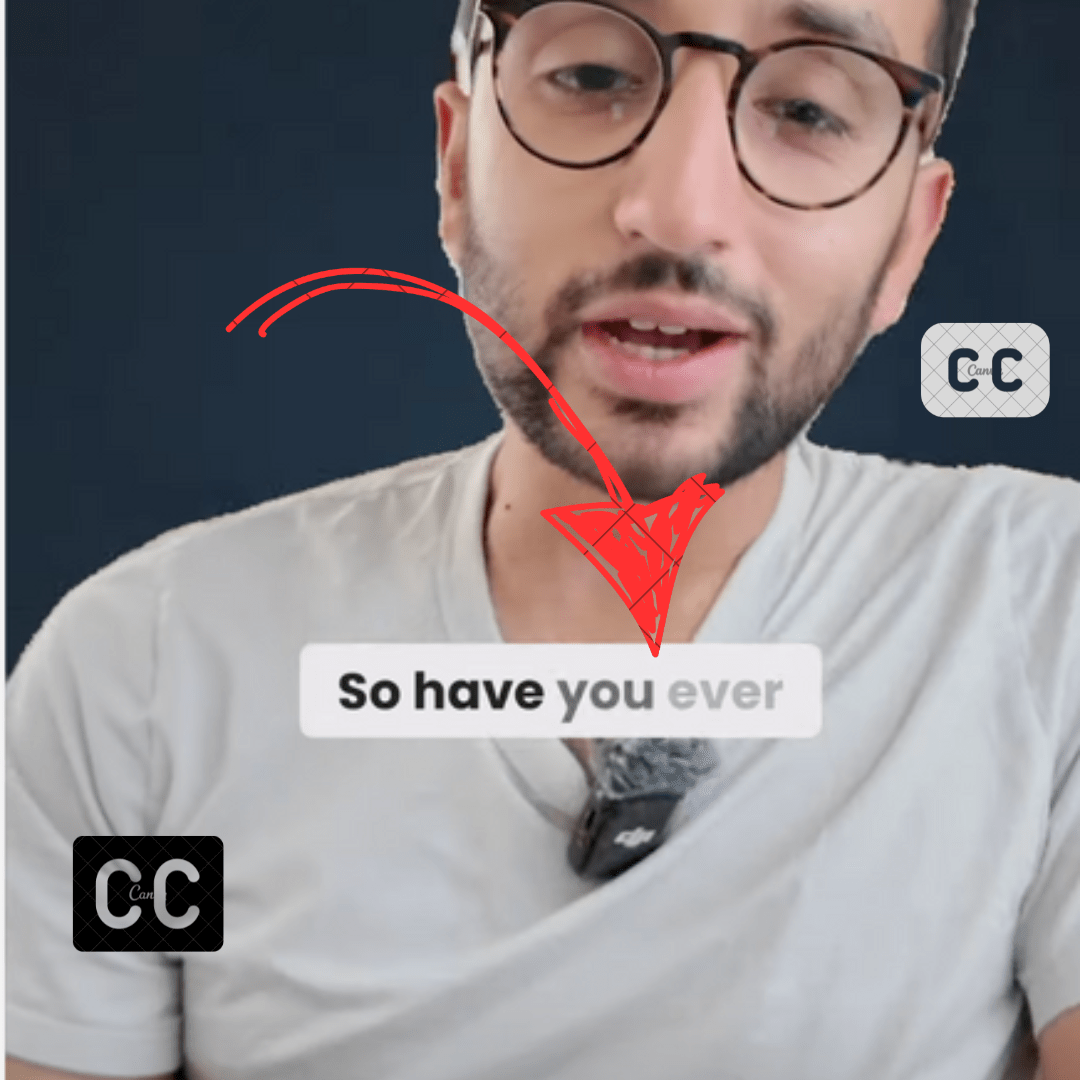Subtitles first appeared in Edwin S. Porter’s 1903 movie, “Uncle Tom’s Cabin.”
Initially known as intertitles, subtitles, or captions, are now standard in videos.
This comprehensive survey provides the latest statistics on subtitles and captions. It includes insights from both consumers and organizations, highlighting why captions are added and their impact on engagement and views.
The data is sourced from four different studies, detailed at the end.
Here are the Top Key Findings
- 89% indicated they have used subtitles in the past
- All surveys show that the Younger audience is obsessed with captions
- Poor audio quality, difficult accents, and noisy environments are the main reasons people use subtitles
- 90% of Organisations add captions to their videos
- Most organizations use auto-captions with and without human efforts
- A YouTube channel found 13.48% more views in the first two weeks and 7.32% more lifetime views.
How many People Use subtitles?
50% of People use subtitles most of the time while watching content online according to a Preply survey.
89% of people have used subtitles in the past, as indicated by the same study.
38% of customers generally watch TV with subtitles in their known language. 8% of users are not sure according to YouGov survey.
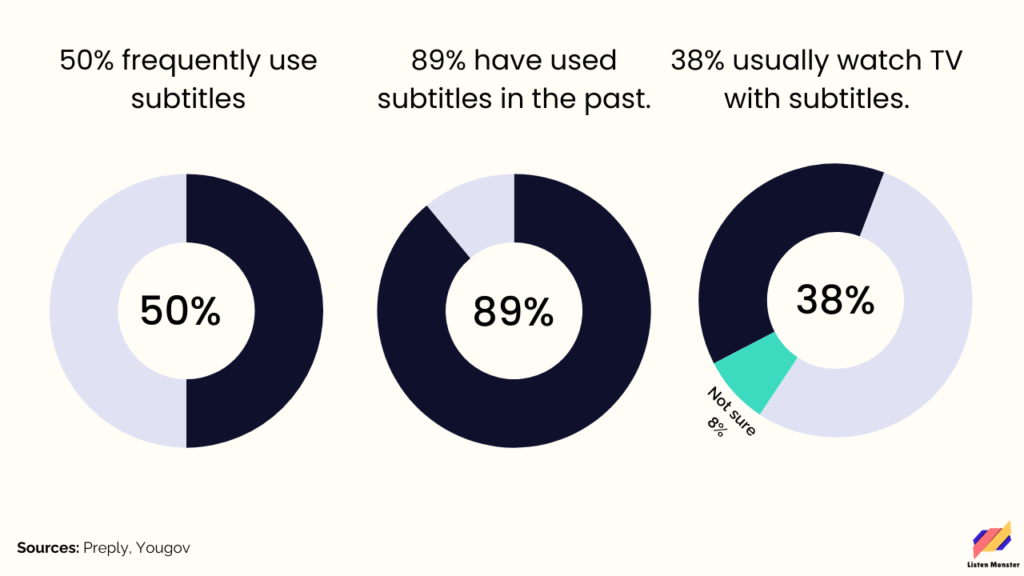
Watching TV with subtitles often does not provide proper indications. Here is further detailed data on how exactly people are using subtitles.
- 13% of people always watch TV with subtitles.
- 17% of people watch TV with subtitles most of the time.
- 15% of people sometimes watch TV with subtitles.
- 21% of people rarely watch TV with subtitles.
- 34% of people never watch TV with subtitles.
Here is a breakdown by Gender and age.
| Total | Male | Female | 18-29 | 30-44 | 45-64 | 65+ | |
|---|---|---|---|---|---|---|---|
| Always | 13% | 13% | 14% | 23% | 16% | 8% | 8% |
| Most of the time | 17% | 17% | 16% | 28% | 19% | 10% | 12% |
| Sometimes | 15% | 13% | 17% | 18% | 15% | 15% | 14% |
| Rarely | 21% | 20% | 21% | 18% | 23% | 19% | 23% |
| Never | 34% | 38% | 31% | 12% | 27% | 48% | 43% |
Frequency of Watching Videos On Mute
85% of videos on social media are watched without sound. This indicates that users generally prefer to watch social videos on mute.
In contrast, only 2% of people prefer to watch with the sound off when it comes to watching TV.
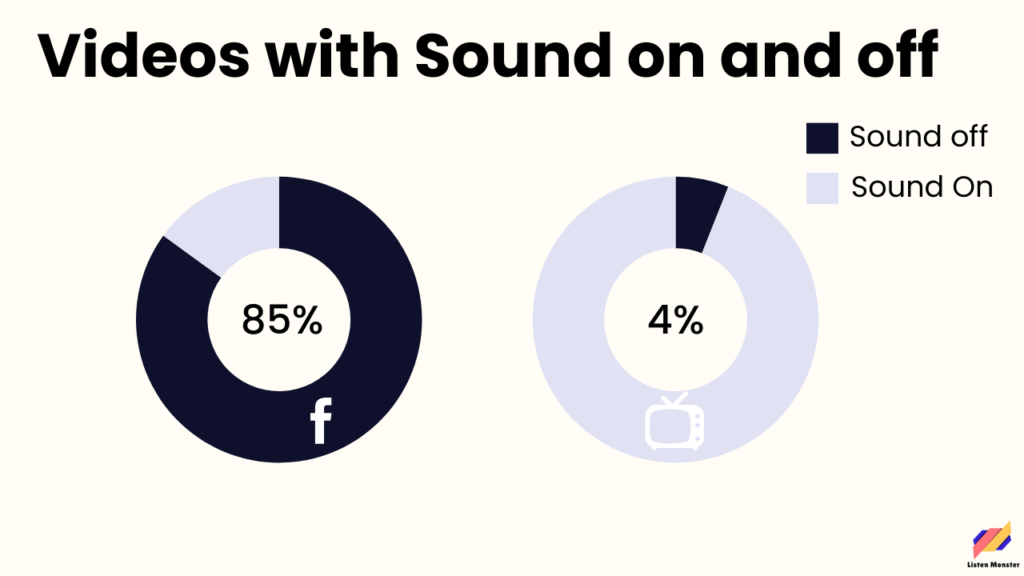
This stark difference highlights how viewing habits are influenced by the platform and the context in which content is consumed.
Facebook data was published in 2016. We believe this number would likely be different in 2024.
Mute and captions are related in a way that impacts viewer behavior and comprehension, as illustrated by the stats from the Verizon case study:
- 37% of viewers are likely to turn on the audio when captions are available, suggesting that captions can engage viewers enough to make them want to experience both visual and auditory elements of the content.
- 29% of viewers reported that they were better able to understand the video with the sound off, thanks to the captions. This indicates that captions play a critical role in comprehension, especially when the audio is muted or unavailable.
Why do people use video subtitles?
72% of users prefer to use subtitles due to poor audio quality, as reported by Preply.
42% of users said that subtitles help them concentrate while watching content or TV, as revealed by a survey by Stagetext.
Audio-related issues, such as difficult accents, noisy environments, and hearing impairments, are the main reasons people use subtitles, as reported by YouGov research.

Here is a detailed breakdown of the reasons why people use subtitles when watching TV in a language they understand, according to YouGov data:
- 19% use subtitles due to hearing difficulties.
- 7% use subtitles to help them learn a new language.
- 27% use subtitles for enhanced comprehension of the content.
- 10% use subtitles because they are sensitive to loud sounds.
- 26% use subtitles to help understand different accents.
- 22% use subtitles in noisy environments.
- 14% use subtitles to avoid disturbing others.
- 13% use subtitles to appreciate the dialogue more fully.
- 9% use subtitles due to the preference of fellow viewers.
- 10% use subtitles to enable multitasking while watching TV.
- 3% cited other reasons for using subtitles.
- 34% were not asked as they never use subtitles.
Here is a further breakdown by age and gender.
| Total | Male | Female | 18-29 | 30-44 | 45-64 | 65+ | |
|---|---|---|---|---|---|---|---|
| Hearing difficulties | 19% | 18% | 21% | 25% | 17% | 12% | 27% |
| Learning a new language | 7% | 8% | 5% | 14% | 11% | 2% | 1% |
| Enhanced comprehension | 27% | 26% | 27% | 36% | 36% | 19% | 20% |
| Sound sensitivity | 10% | 10% | 11% | 19% | 11% | 8% | 6% |
| Helps to understand accents | 26% | 23% | 29% | 41% | 30% | 20% | 18% |
| In a noisy environment | 22% | 19% | 24% | 36% | 26% | 14% | 15% |
| To avoid disturbing others | 14% | 14% | 14% | 16% | 18% | 13% | 10% |
| Appreciation of dialogue | 13% | 13% | 12% | 19% | 18% | 9% | 7% |
| Preference of fellow viewers | 9% | 8% | 10% | 18% | 9% | 8% | 2% |
| To enable multitasking | 10% | 9% | 11% | 20% | 14% | 5% | 5% |
| Other reason | 3% | 3% | 2% | 2% | 2% | 4% | 3% |
| Not asked — Never uses subtitles | 34% | 38% | 31% | 12% | 27% | 48% | 43% |
Consumers Want Subtitles Tailored to Different Industries
Captions are desired for most types of content, but the expectation for them varies by content type.
People expect captions more on instructional and informational content. This includes news, food content, and tips/advice.
Over 50% of survey respondents expect captions on these types of content.
| Category | Percentage |
|---|---|
| Tips/Advice | 55% |
| Food | 53% |
| News | 52% |
| Movies/TV | 49% |
| Entertainment | 45% |
| Fitness | 43% |
| Sports | 43% |
| Finance | 42% |
| Social Media | 41% |
| Beauty | 40% |
| Lifestyle | 39% |
| Fashion | 35% |
Which Generation Uses subtitles the most?
The young generation uses the subtitle most. Multiple studies have confirmed the same thing.
- 70% of Gen Z prefer subtitles according to the reply.
- 63% of people aged between 18-29 prefer subtitles on reported by YouGov.
- 80% of people aged between 18-25 prefer subtitles, according to Stagetext.
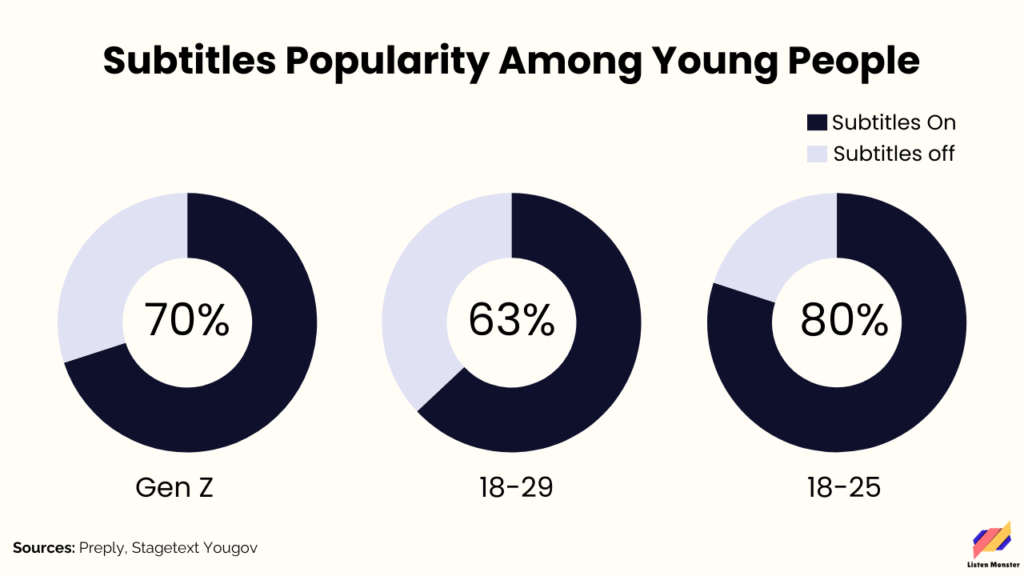
In contrast, Older people don’t prefer subtitles as confirmed by the same studies. Here is the comparison of younger audiences with older audiences.
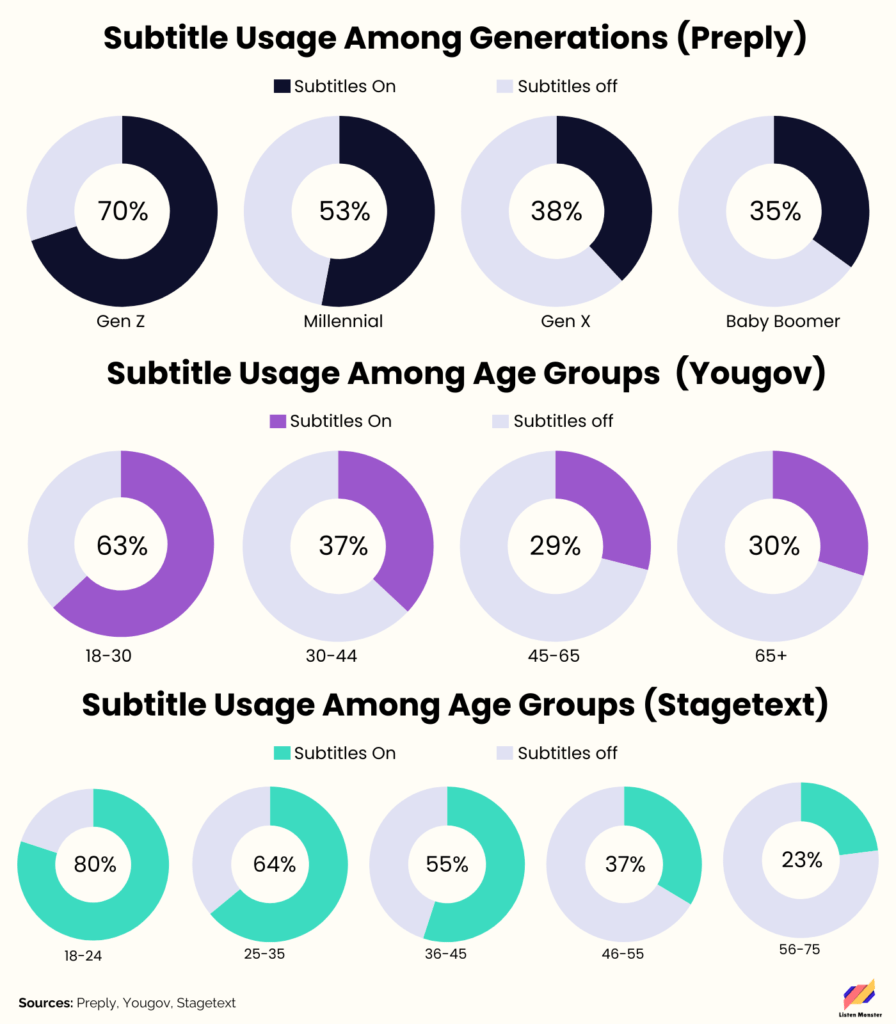
Men vs Women Who Use the Subtitle Most?
Women use the subtitles most. 41% of women prefer to have subtitles on while watching TV. In contrast, only 36% of men prefer watching TV with subtitles on.
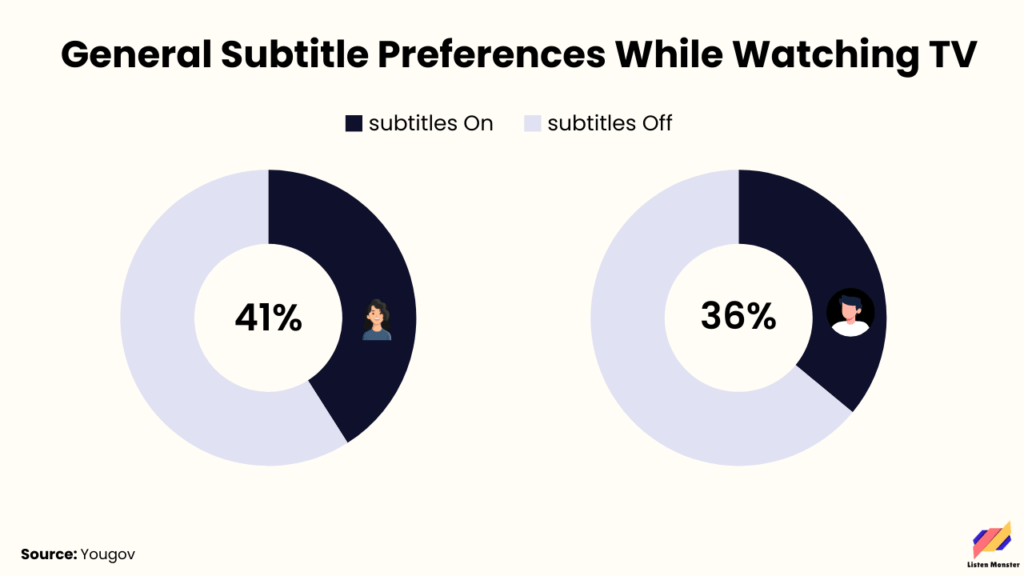
Main Reason People Don’t Use Subtitles
Distraction, and unnecessary, screen cluttering are the main reasons why some don’t use subtitles
Here are the main reasons people don’t use subtitles study by YouGov.
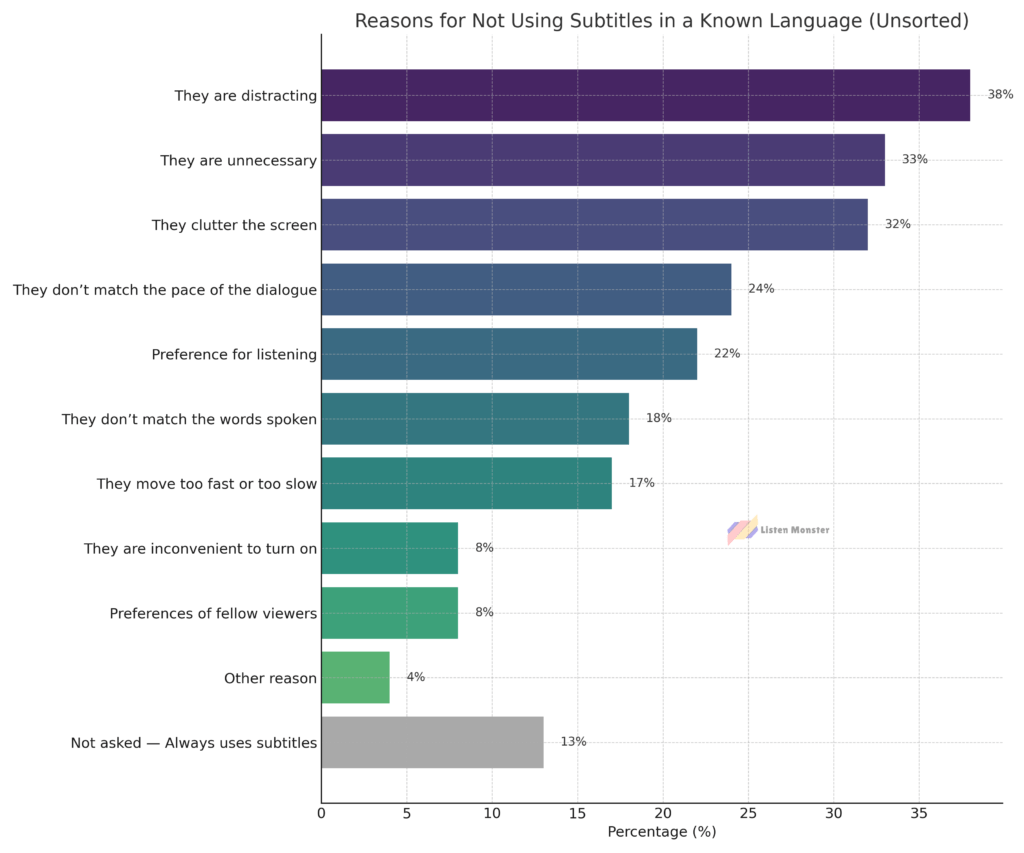
- 38% find subtitles distracting.
- 33% believe subtitles are unnecessary.
- 22% have a preference for listening without subtitles.
- 17% find that subtitles move too fast or too slow.
- 8% find it inconvenient to turn subtitles on.
- 18% note that subtitles do not accurately match the words spoken.
- 24% find that subtitles do not match the pace of the dialogue.
- 32% feel that subtitles clutter the screen.
- 8% choose not to use subtitles due to the preferences of fellow viewers.
- 4% cited other reasons for not using subtitles.
- 13% were not asked as they always use subtitles.
Here is the further breakdown by age group.
| Reason | Total | Male | Female | 18-29 | 30-44 | 45-64 | 65+ | White | Black | Hispanic | Other |
|---|---|---|---|---|---|---|---|---|---|---|---|
| They are distracting | 38% | 37% | 39% | 24% | 30% | 49% | 44% | 42% | 38% | 25% | 27% |
| They are unnecessary | 33% | 34% | 31% | 17% | 26% | 42% | 41% | 37% | 34% | 17% | 16% |
| Preference for listening | 22% | 23% | 22% | 12% | 25% | 27% | 22% | 24% | 23% | 16% | 16% |
| They move too fast or too slow | 17% | 20% | 15% | 19% | 13% | 17% | 20% | 15% | 27% | 20% | 13% |
| They are inconvenient to turn on | 8% | 9% | 8% | 12% | 7% | 8% | 6% | 9% | 9% | 8% | 6% |
| They don’t match the words spoken | 18% | 18% | 18% | 19% | 19% | 16% | 17% | 17% | 18% | 25% | 15% |
| They don’t match the pace of the dialogue | 24% | 26% | 21% | 23% | 28% | 25% | 18% | 24% | 26% | 24% | 17% |
| They clutter the screen | 32% | 33% | 32% | 25% | 27% | 37% | 38% | 36% | 24% | 26% | 26% |
| Preferences of fellow viewers | 8% | 6% | 10% | 10% | 12% | 5% | 4% | 8% | 6% | 9% | 8% |
| Other reason | 4% | 3% | 5% | 5% | 3% | 3% | 4% | 3% | 2% | 2% | 12% |
| Not asked — Always uses subtitles | 13% | 13% | 14% | 23% | 16% | 8% | 8% | 11% | 11% | 22% | 18% |
How Many People Add Captions to Their Videos?
96% of People agree that they are adding captions at least to some of their videos. There are only 3.9% that don’t caption their videos.
These stats are coming from organizations, that are publishing videos.

On social media, 81% are captioning at least some social media content. Here is the full breakdown.
| Social media | All videos | |
|---|---|---|
| All | 27.4% | 33.8% |
| Most | 27.1% | 35.6% |
| Some | 26.2% | 20.9% |
| A little | 10.3% | 5.9% |
| None | 8% | 3.9% |
Why do Creators add captions to their videos?
Creators add captions for various reasons. Accessibility is the biggest reason why creators are captioning their videos.
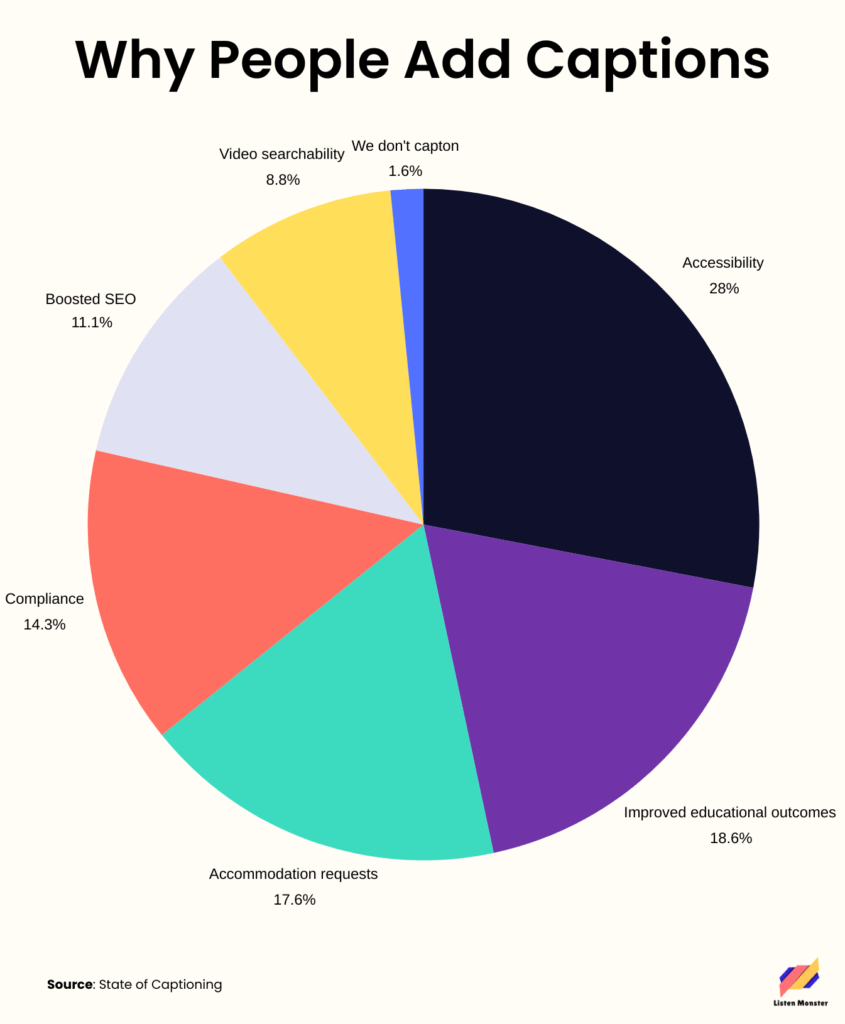
Here is a further breakdown of this
- 60.6% add captions for accessibility and to ensure equal access.
- 40.3% do it to improve educational outcomes.
- 38% respond to accommodation requests.
- 31% add captions for compliance and to avoid litigation.
- 24.1% aim to boost SEO and engagement.
- 19.1% enhance video searchability.
- 3.4% do not add captions to their videos
How are People adding Captions to their videos?
76% of People are adding captions using auto-captions with and without edits.
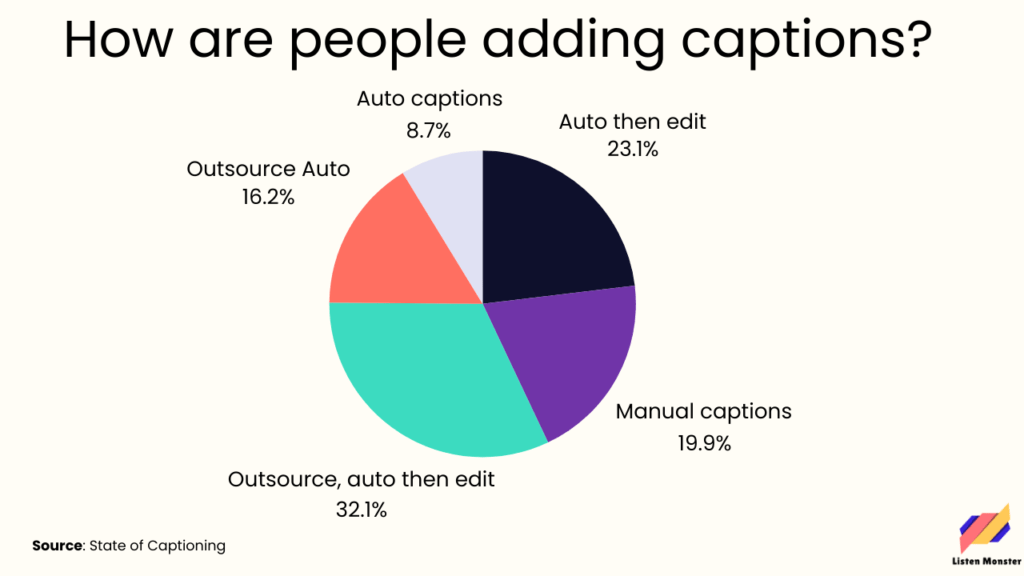
- 27.3% start with automatic captions and then edit them.
- 23.5% do not use automatic captions at all.
- 19.8% use outsourcing, which starts with automatic captions and then edits them.
- 19.1% use outsourcing for automatic captioning.
- 10.3% always use automatic captions.
Subtitles vs Dubbing: What do creators Choose?
Most creators prefer adding subtitles instead of Dubbing.
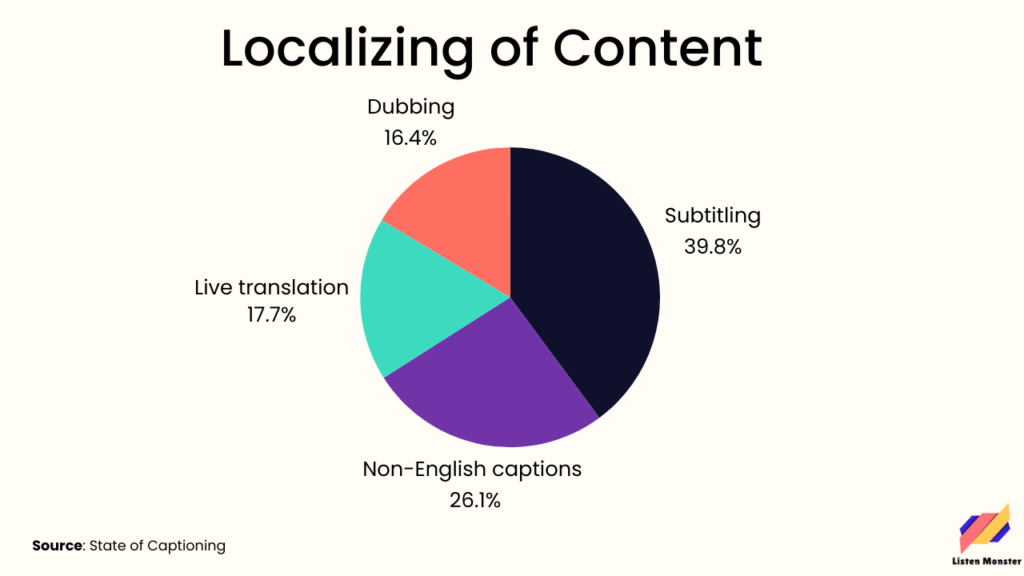
We believe this is the reason due to the cost and imperfections of Dubbing. Overall, dubbing has increased by 17% from last year.
We believe in the future we will see more people dubbing their content into another language.
Subtitles Impact on Reach and Engagement?
Subtitles and direct impact on reach and engagement. Discovery Network Plus (Currently not active) found an increase in views
13.48%
Increase in Views in the first 14 days
7.32%
Increase in Views over the lifetime period
A 12% increase in engagement in advertisements after adding subtitles was shown by the meta report. This is why they have added automatic captioning on Facebook.
A similar result has been found in the version case study
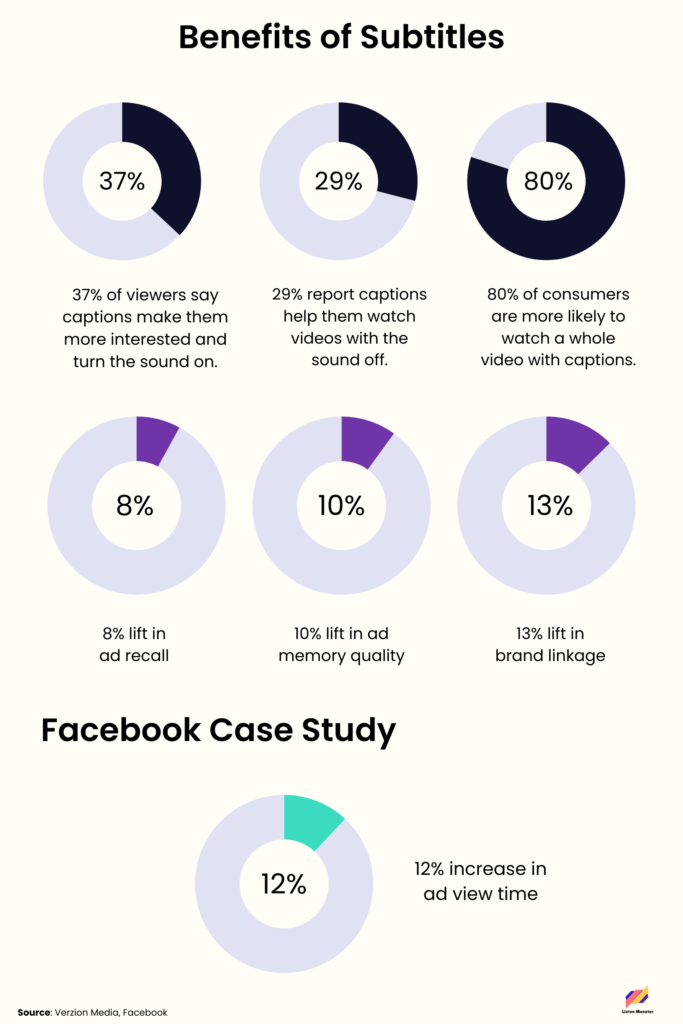
Sources
Yougov Subtitles Study: This survey was conducted on June 29 – July 5, 2023, on 1000 Americans. This survey has ±3.9% margin of error.
Verizon Media and Publicis Media: This survey was conducted on 5,616 U.S. adults aged 18 to 54 conducted in April 2019.
Preply survey: It was done on 1,260 Americans in 2022.
The 2024 State of Captioning Report was done on 450+ respondents across as many industries
Stagetext survey: This research was conducted in 2023 by the Audience Agency on behalf of Stagetext. The survey included over 2,400 participants who were representative of the UK’s population.
Final words
Subtitles are an essential part of today’s media landscape, playing a crucial role in how we consume videos across various platforms.
They have grown far beyond their original purpose of aiding those with hearing impairments to become a vital tool for viewers worldwide.
Particularly popular among younger audiences, subtitles help bridge language barriers and enhance comprehension, especially in noisy environments or when dealing with difficult accents.
For content creators, subtitles are more than just an accessibility feature; they are a strategic element in video production. Incorporating subtitles can significantly boost viewer engagement and extend the reach of content to a global audience.
This is particularly evident in social media platforms where videos often play without sound by default, making subtitles indispensable for capturing the viewer’s attention.
Moreover, the use of subtitles supports learning and comprehension, helping viewers retain information better, especially when dealing with complex or educational content.
As technology continues to advance, the process of adding subtitles to videos has become more streamlined, with automatic captioning services becoming more accurate.
However, the human touch remains crucial, as automatic captions often require further editing to ensure accuracy and context.
In conclusion, Subtitles are no longer a Luxury, they are necessary.



